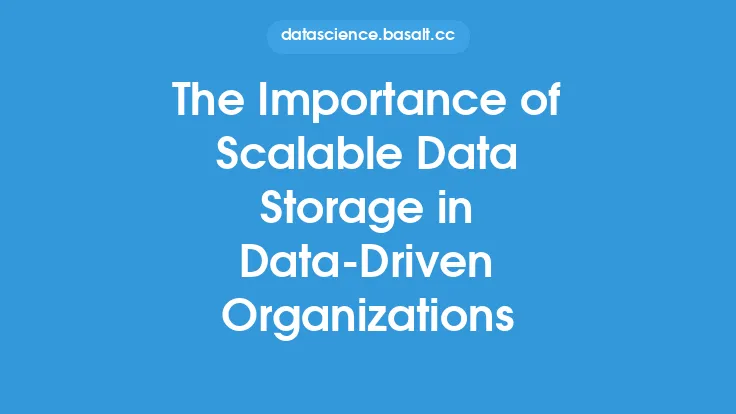When it comes to choosing the right data storage technology, there are several factors to consider. The type of data, the amount of data, and the intended use of the data are all important considerations. Additionally, the performance, scalability, and reliability of the storage technology are also crucial factors. In this article, we will explore the different types of data storage technologies available, their characteristics, and the factors to consider when choosing the right one for your needs.
Types of Data Storage Technologies
There are several types of data storage technologies available, each with its own strengths and weaknesses. These include:
- Hard Disk Drives (HDDs): HDDs are a traditional type of storage technology that uses spinning disks and mechanical heads to read and write data. They are relatively inexpensive and offer high storage capacities, but they can be slow and prone to mechanical failure.
- Solid-State Drives (SSDs): SSDs are a type of flash-based storage technology that uses interconnected flash memory chips to store data. They are faster and more reliable than HDDs, but they can be more expensive and have limited storage capacities.
- Flash Storage: Flash storage is a type of non-volatile storage technology that uses flash memory to store data. It is commonly used in SSDs, but it can also be used in other devices such as USB drives and memory cards.
- Hybrid Storage: Hybrid storage combines different types of storage technologies, such as HDDs and SSDs, to offer a balance between performance and capacity.
- Cloud Storage: Cloud storage is a type of storage technology that stores data remotely over the internet. It offers scalability, flexibility, and accessibility, but it can be vulnerable to security risks and dependent on internet connectivity.
Characteristics of Data Storage Technologies
When choosing a data storage technology, there are several characteristics to consider. These include:
- Performance: The performance of a storage technology refers to its ability to read and write data quickly. This is typically measured in terms of throughput, latency, and IOPS (input/output operations per second).
- Capacity: The capacity of a storage technology refers to the amount of data it can store. This is typically measured in terms of gigabytes (GB), terabytes (TB), or petabytes (PB).
- Reliability: The reliability of a storage technology refers to its ability to withstand failures and maintain data integrity. This is typically measured in terms of mean time between failures (MTBF) and mean time to recover (MTTR).
- Scalability: The scalability of a storage technology refers to its ability to grow and adapt to changing data needs. This is typically measured in terms of its ability to add or remove storage capacity, as well as its ability to handle increased workloads.
- Security: The security of a storage technology refers to its ability to protect data from unauthorized access or theft. This is typically measured in terms of its encryption, access controls, and authentication mechanisms.
Factors to Consider When Choosing a Data Storage Technology
When choosing a data storage technology, there are several factors to consider. These include:
- Data Type: The type of data being stored is an important consideration. For example, video and audio files require high-capacity storage, while databases and transactional data require high-performance storage.
- Data Size: The amount of data being stored is also an important consideration. For example, large datasets require high-capacity storage, while small datasets can be stored on smaller devices.
- Performance Requirements: The performance requirements of the application or workload are also an important consideration. For example, real-time analytics and high-performance computing require high-performance storage, while batch processing and archival storage can use lower-performance storage.
- Budget: The budget for the storage technology is also an important consideration. For example, high-end storage technologies like SSDs and flash storage can be expensive, while lower-end technologies like HDDs and tape storage can be more affordable.
- Scalability and Flexibility: The ability of the storage technology to scale and adapt to changing data needs is also an important consideration. For example, cloud storage and object storage can be highly scalable and flexible, while traditional storage technologies like HDDs and SSDs can be less scalable and flexible.
Technical Considerations
When choosing a data storage technology, there are also several technical considerations to keep in mind. These include:
- Interface: The interface of the storage technology refers to the way it connects to the host system. Common interfaces include SATA, SAS, PCIe, and NVMe.
- Protocol: The protocol of the storage technology refers to the way it communicates with the host system. Common protocols include TCP/IP, NFS, and SMB.
- File System: The file system of the storage technology refers to the way it organizes and manages data. Common file systems include NTFS, HFS+, and ext4.
- Data Protection: The data protection mechanisms of the storage technology refer to the way it protects data from corruption or loss. Common data protection mechanisms include RAID, mirroring, and snapshots.
Conclusion
Choosing the right data storage technology is a complex decision that depends on several factors, including the type of data, the amount of data, and the intended use of the data. By considering the characteristics of different storage technologies, such as performance, capacity, reliability, scalability, and security, and by evaluating the technical considerations, such as interface, protocol, file system, and data protection, you can make an informed decision that meets your needs and budget. Whether you are storing large datasets, high-performance workloads, or sensitive data, there is a data storage technology that can meet your requirements and help you achieve your goals.





